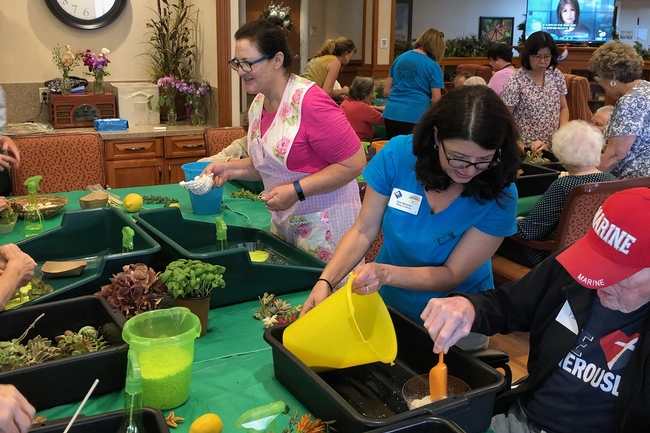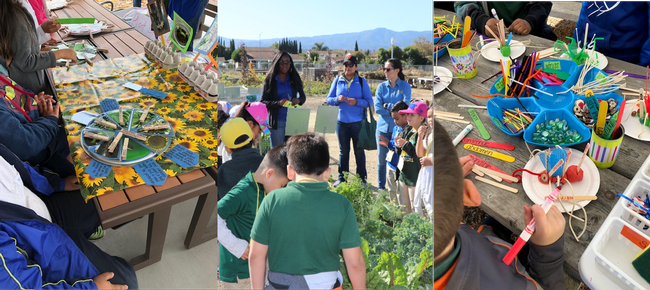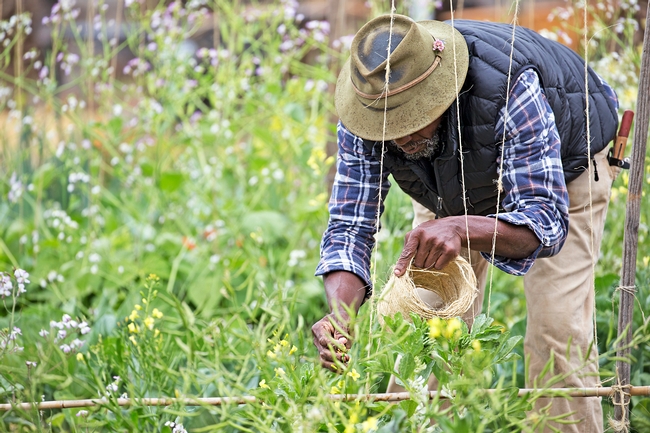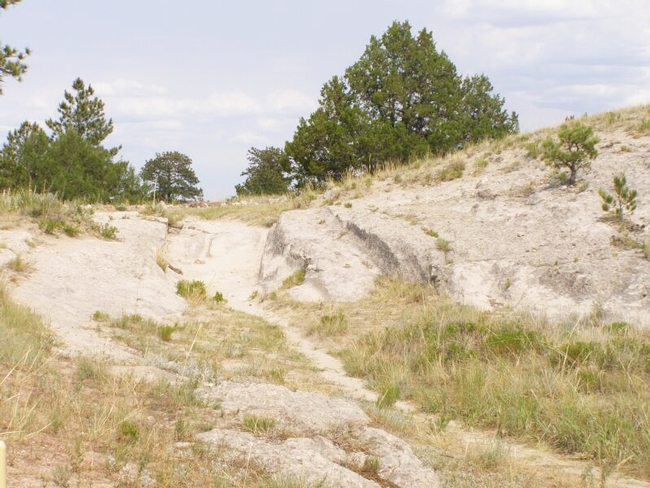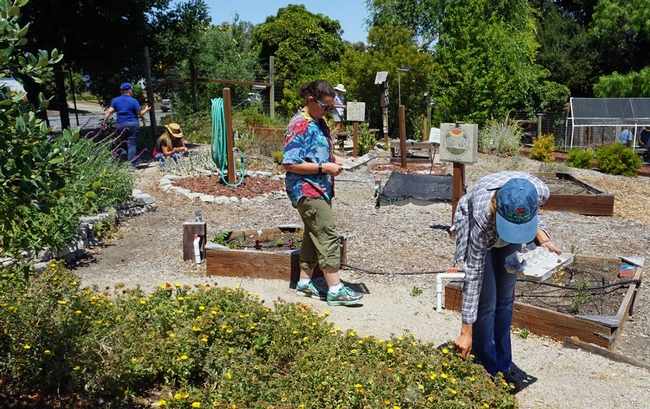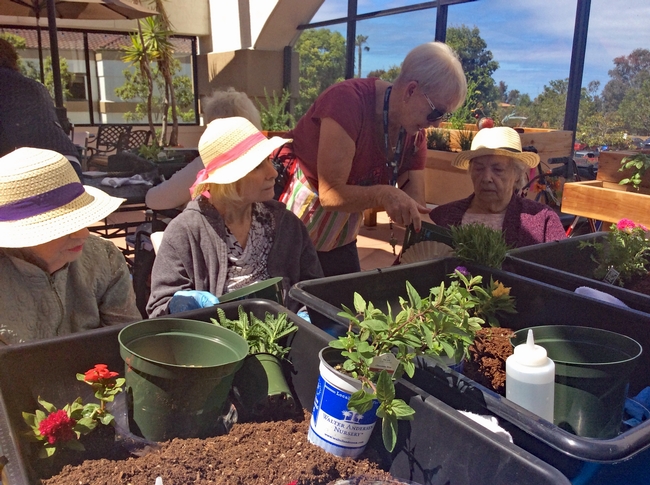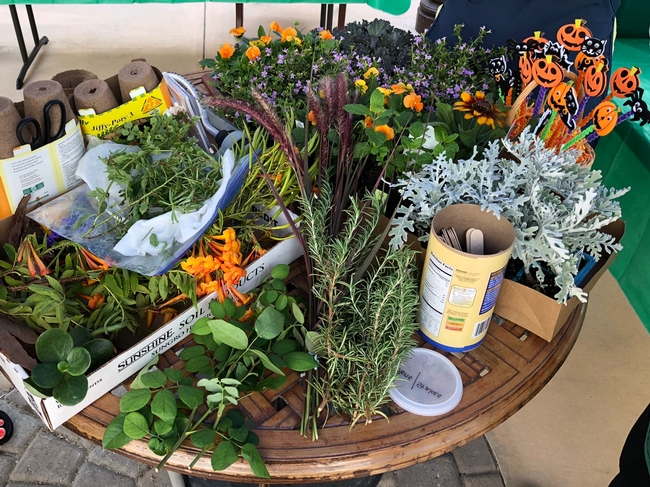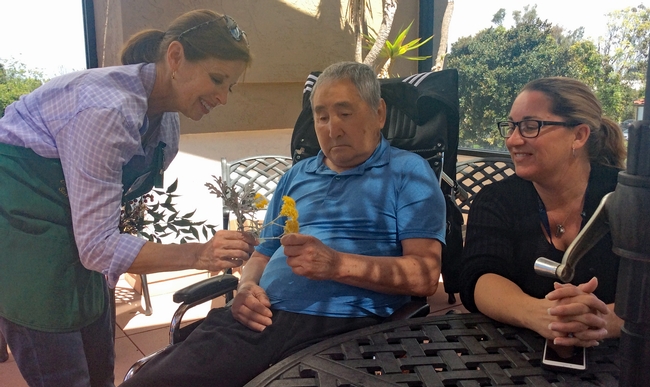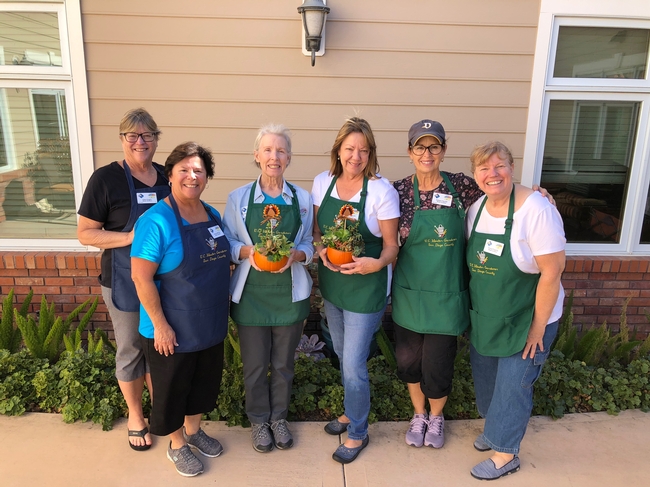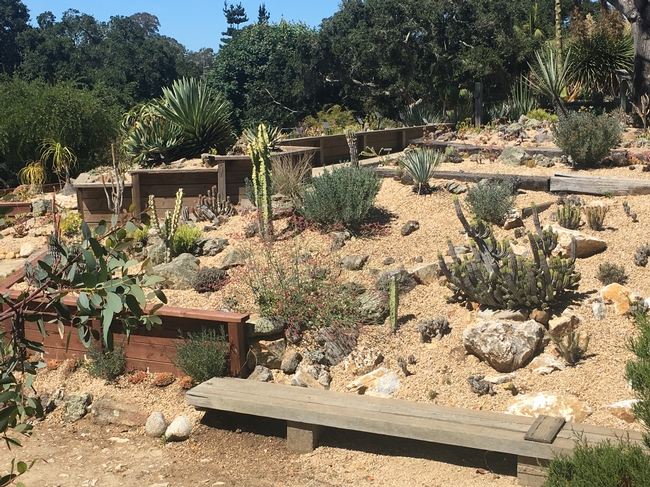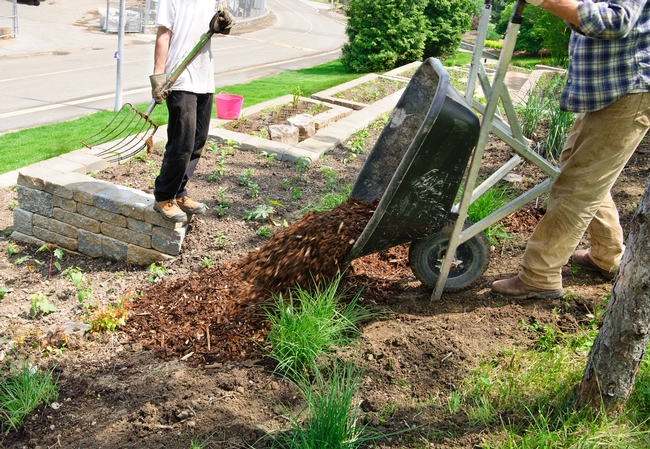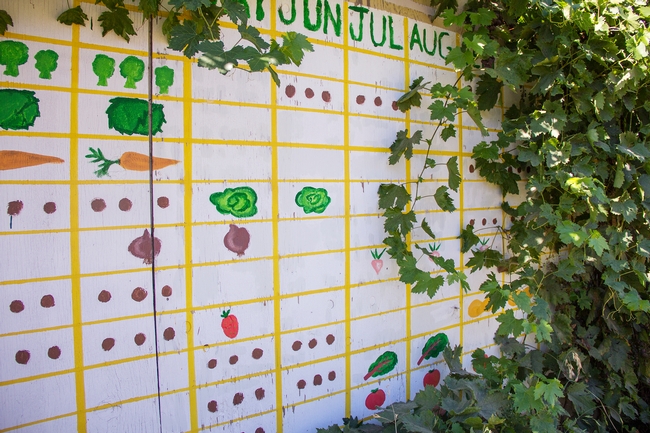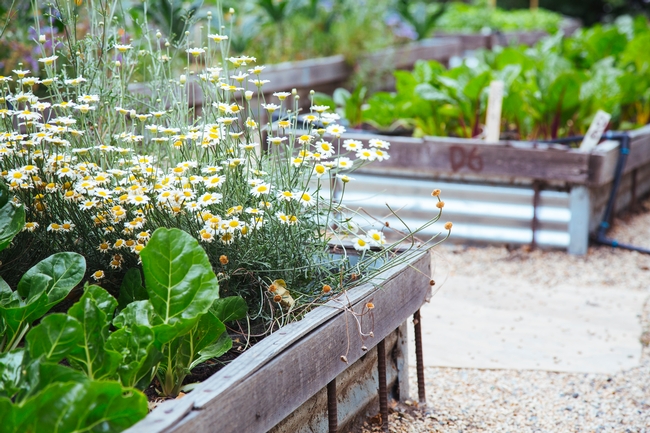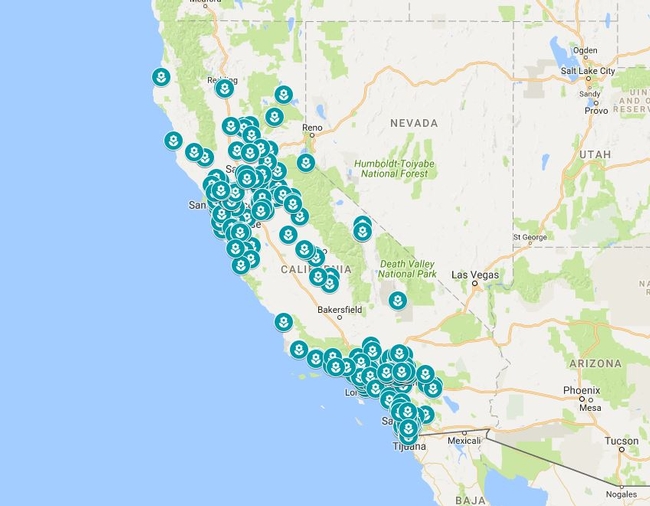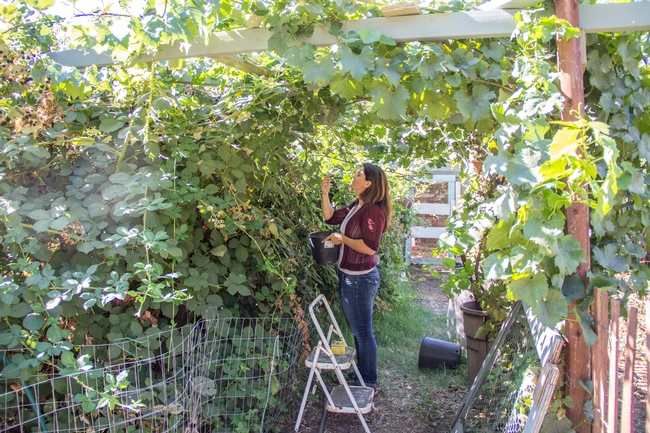Posts Tagged: Master Gardener Program
To reach vets, kids, older adults, UC Master Gardeners partner with community organizations
Successfully supporting farming, homemaking and youth development with science-based solutions during UC Cooperative Extension's first 60 years in California prompted UC Agriculture and Natural Resources leaders to consider other ways the same concept could improve American lives.
One of those was the development of the UC Master Gardener Program in 1980, which recognized the need for science to inform sustainable and safe home food production for healthy diets, physical activity, education and mental well-being.
Over the years, the program has trained tens of thousands of UC Master Gardener volunteers to support residents of more than 52 California counties with environmentally sound ways to manage garden pests, reduce water use and grow fruits and vegetables. Today, there are more than 6,000 active UC Master Gardener volunteers.
Each of the 52 counties within the UC Master Gardener Program has unique projects that support its community needs, from reducing water use in home landscapes, diverting green waste from landfills and creating pollinator habitats to support pollinator populations. All counties answer gardening questions for free using a telephone hotline or email inquiry system. Master Gardener volunteers in many counties support community, school and demonstration gardens to share knowledge and spark inspiration. All focus their efforts on education.
To make still greater gains in outreach efforts, the UC Master Gardener Program enlists community partners that share its values. For example, the UC Master Gardener Program in Contra Costa County works with the County Department of Behavioral Health, Bi-Bett Corporation, Eden Housing and the Veteran's Affairs campus to provide gardening lessons to older adults, behavioral health patients and veterans.
“Gardens bring people together, regardless of race, color, age, sex, disability or religion,” said Missy Gable, statewide director of the UC Master Gardener Program. “Our volunteers in Contra Costa County carefully identified key gardening topics and the best delivery options for a variety of learning styles.”
The lessons covered vegetable gardening, soil health, composting, supporting pollinators and garden pest management.
UC Master Gardener volunteers in San Diego County worked with residential memory care communities and Alzheimer's San Diego to offer sensory gardening activities to people with dementia. The ‘Reminiscence Gardening' project in San Diego County was funded with a community grant and donations.
“Participants explored herbs, fruits and vegetables to activate the senses of sight, touch and smell,” Gable said. “In doing so, they worked their brains and their bodies, connecting their senses with memories, all the while also working on fine motor skills and muscle tone.”
In Santa Clara County, UC Master Gardener volunteers developed science- and nutrition-based field trip activities to present at their demonstration garden and, with local grants, help pay to transport children from low-income neighborhoods to the garden for a day of hands-on learning.
Children learned about the plant life cycle and planted sunflower seeds to take home and watch grow. They tasted vegetables and discovered the benefits of eating fresh produce of many colors. After learning how to collect insects and identify them, UC Master Gardener volunteers invited them to release beneficial insects at the park.
“UC Master Gardener volunteers encouraged the children to return to the garden with their families to share their experiences,” Gable said. “Children are often an important driver of both food and recreation choices for families so encouraging them to continue their gardening journey is key to seeing change at the family level.”
During the COVID-19 crisis, when many families and children had to stay at home for their protection, interest in home gardening surged. UC Master Gardener volunteers and coordinators sought out safe ways to reach new gardeners with research-based information.
In Calaveras County, UC Master Gardener volunteers provided gardening kits for school children distance-learning at home. UC Master Gardeners in San Bernardino County offered monthly gardening sessions via Zoom to their community. UC Master Gardeners in Contra Costa and Alameda counties donated vegetable transplants to students and families in the Oakland Unified School District. In Santa Barbara County, volunteers taught local residents how to grow an abundance of high-demand fruits and vegetables for food banks.
“Our volunteers didn't skip a beat,” Gable said. “They live and work in the communities we serve, so they can identify where needs are and connect with like-minded partners to provide the widest possible distribution of trusted gardening information.”
The UC Master Gardener Program and other UC ANR statewide programs rely on donor contributions. To learn more about how to support or get involved with the UC Master Gardener Program in your community, visit mg.ucanr.edu.
Home gardening is more pleasant and successful with healthy soil
With winter soon upon us, it's a good time to treat your garden bed just like the one where you tuck in at night, says Dustin Blakey, UC Cooperative Extension advisor, director and UC Master Gardener coordinator in Inyo and Mono counties.
Blakey hosted a webinar on Facebook during Healthy Soils Week 2020 (Nov. 30 – Dec. 5) to advise home gardeners how to promote healthy soils to maximize their gardening success.
“Some genius suggested we call garden plots ‘beds,'” he said. “It makes sense. Mom was right. Don't stand or walk on the bed. Keep it neat and tidy. And cover it, in the case of a garden bed, with organic mulch.”
The goal is to end up with garden soil that holds adequate water, nutrients and air, supports soil life forms, like worms, insects and microorganisms, and is convenient to work with.
“If I have to get a mallet to bang a trowel into the ground, it's not healthy soil,” Blakey said.
As a first step, designate permanent walkways in the garden so only those areas become compacted by foot traffic, leaving the plots where vegetables will be grown undisturbed.
“Along parts of the Oregon Trail, almost 200 years later you can still see the ruts where the wagon wheels rolled, and plants aren't growing there,” Blakey said.
He recommended gardeners cover their walkways with gravel, decomposed granite or organic materials like wood chips, bark or grass. Installing raised garden beds is an ideal way to differentiate growing and walking areas. In his own garden, Blakey built the beds four feet wide to have easy access to all the plants while standing on the walkways.
Add compost to the soil inside the beds to reap a variety of benefits.
“It's often said, no matter the problem, compost is the solution,” Blakey said.
Compost provides a food source for beneficial microorganisms in the soil. If soil is sandy, compost helps it hold water and nutrients. If the soil is clay-like, compost loosens the soil, making it more friable.
Covering the garden soil surface with mulch or cover crops is also critical to soil health, Blakey said. The topping moderates the soil temperature, supporting the organisms living below ground. The covering helps prevent weeds, and as the mulch breaks down, it adds organic matter to the soil.
“You can also grow cover crops,” Blakey said. “I'm surprised how few gardeners use cover crops. Put some seeds in the ground instead of buying a bag of amendments.”
Cover crops can be part of a healthy garden crop rotation, keeping roots growing in the soil all year long.
“Grasses scavenge nutrients. Legumes fix nitrogen. I grow sweet potatoes. They shade everything and keep the weeds at bay. A daikon radish cover crop penetrates deep into the ground, naturally tilling the soil,” he said.
Blakey discourages a common habit of some long-time gardeners, frequent rototilling with a heavy machine, and rather encourages what he calls “gentle tilling.”
“You don't need power equipment. Experiment with using a shovel,” he said. “My soil is loose and easy to work. Some beds, I don't even turn. I just plant directly in the healthy soil.”
View a recording of Blakey's one-hour webinar on healthy soil on the UC Master Gardener Program Facebook page: https://www.facebook.com/UCMasterGardeners. The UC Master Gardeners offer many online gardening resources and programs in most California counties. Find your local program at http://mg.ucanr.edu/FindUs.
UC Master Gardeners partner with Alzheimer's San Diego in Reminiscence Gardening project
The UC Master Gardener Program of San Diego County has always been open to innovative ways of expanding its mission and passion for gardening into new parts of its community. The San Diego program has a rich history of successful partnering with other local organizations to reach under-served populations. An exciting new collaboration was unveiled in March 2018 when five UC Master Gardener volunteers took their newest public outreach project Reminiscence Gardening to the Alzheimer's San Diego's (AlzSD) social activities program.
Thirty participants, all community members being served by AlzSD, got their hands dirty and enjoyed a day of sensory stimulation through tabletop gardening activities planned by the UC Master Gardener leaders. The 90-minute program gave participants the opportunity to touch, move, smell, hear and see the joys of manipulating soil and plants to construct a simple potted creation to adorn their spring celebration table.
UC Master Gardener volunteers knew it would be important to develop activities that were fun and, hopefully, something those in attendance had previously enjoyed. With marigolds, chrysanthemums and mint varieties in hand, participants and caregivers, worked side-by-side and guided by UC Master Gardeners, dug into the bins filled with soil, pots and tools. Each set of participants was given three plants to pot up. As this first activity progressed, UC Master Gardeners could see that participants were being drawn out and interactions around the worktable were increasing. The physical, intellectual, emotional and social benefits of gardening were being experienced and shared by all.
Other sensory-heavy opportunities, all planned and guided by UC Master Gardeners, were included in the program. Participants were asked to reach into a bin filled with loose soil and wriggler worms to re-familiarize themselves with that most basic part of backyard gardening – working the soil. A variety of plants in one-gallon containers were passed around. Each container was specially marked with an icon that invited the participants to experience the visual beauty, familiar smell, unique feel and, sometimes, sound and subtle taste of each plant.
Of particular interest was an activity in which everyone was asked to explore a box filled with hand tools, seed packets and other items typically used in backyard gardening. Clearly, old memories were refreshed. A vintage hose nozzle drew the attention of one gentleman. He held it for a while then began making the motions used in hand-watering the yard, moving the nozzle back and forth while mimicking the sound of water rushing forth from the attachment onto a once green and promising flower bed. Tangible signs of success, such as these, were everywhere during the social activity.
Jessica Empeño, MSW, Alzheimer's San Diego's Vice President of Programs and Services was in attendance and praised the work of the UC Master Gardener volunteers.
“Gardening was such a treat for our families. This activity stimulated all the senses – from the gorgeous colors of the flowers, the smell and taste of the herbs and the chatter and laughter that filled the room. Most importantly, those living with dementia and their care partners were able to socialize and have fun in a safe, judgment-free setting. We are so grateful to the UC Master Gardener Program for donating their time and supplies. We hope to have them back soon!”
The UC Master Gardener Program of San Diego was inspired by its growing understanding of the need for more everyday experiences to address the issues facing members of our community being affected by dementia-related diseases. Those numbers are increasing at a staggering rate. The National Alzheimer's Association estimates that currently 5.7 million Americans have been diagnosed with Alzheimer's, with nearly two-thirds of those being women, and that number will almost triple by mid-century. In San Diego County, AlzSD offers social activities for individuals with dementia and their caregivers. The “Reminiscence Gardening” project's goal for those individuals is to boost energy levels, build confidence, prolong maintenance of existing skills and perpetuate a sense of purpose and joy through gardening.
Further collaborations between the UC Master Gardener Program of San Diego County and other memory care communities are in the works. UC Master Gardeners want to share their love of gardening and their advanced training from the university for the benefit of those in our community who need it the most. Many of us know first-hand the responsibility of caring for a family member with a dementia-related disease. We know, too, the joys and benefits of being outdoors and sharing time together with people we love. We want to make a meaningful difference in our community and the Reminiscence Gardening project is a wonderful way to express that.
For a calendar of future events and more information about other programs offered by the UC Master Gardener Program of San Diego and Alzheimer's San Diego, please visit:
www.mastergardenersd.org
www.alzsd.org
Hot weather tips for the summer garden
This week much of California is under a heat advisory or excessive heat warning, with high temperatures estimated to range from 90 to 108 degrees. Many home gardeners are wondering how they can help their plants, trees or shrubs survive the intense summer heat.
“We are getting a lot of inquiries around the state from people worried about how the extreme temperatures are going to affect the plants or trees in their yards,” said Missy Gable, director of the UC Master Gardener Program. “With a little extra planning, you can help your garden beat the heat and survive the hot summer weather.”
UC Master Gardener volunteers are available to help answer gardening questions and provide advice on gardening during the hot summer months. Here are four quick and easy ways to help make sure your plants and trees not only survive, but thrive.
- Don't fertilize plants or trees during hot summer months
Fertilizers aim to increase the growth of plants and trees. When a fertilizer is applied, especially one that is high in nitrogen, a plant is triggered to produce more green growth. An increase in growth means an increase in water and nutrient needs. During hot spells, it is especially hard to keep up with plant water and nutrient needs as soils dry out quickly and water may not be readily available. Save your plants (and yourself!) from stress by stopping fertilizer application before hot weather hits. - Water trees deeply and less frequently
It sounds counter intuitive to water trees less frequently, but this is exactly what UC environmental horticulture experts recommend. “When watering trees you want to consider the roots below the tree and you want to encourage a network of deep roots. If you are only watering for short periods at a higher frequency, the roots will remain shallow since that is where the tree finds its water supply,” said Janet Hartin, UC ANR environmental horticulture advisor. “Deep roots mean a healthier tree that is less susceptible to disease.”
How much water a plant needs depends on the specific plant, how long it has been in the ground, and the type of soil where it is planted. In general, young plants or newly planted plants require more water than older more established plants. Clay soils absorb water slowly so watering can take longer but is typically done less frequently. This is in contrast to sandy soils that moisten and drain quickly. Typically, watering sandy soils take less time but has to be done more frequently. A Landscape Irrigation Scheduling Worksheet from the California Center for Urban Horticulture (CCUH) can be used to help calculate and determine an annual irrigation schedule for one irrigation zone.
- Mulch, mulch, and more mulch
When temperatures get extreme, having a good layer of mulch prevents soil from heating up excessively and loosing water to evaporation. Apply 4 inches of a medium shred bark mulch to insulate the soil. This protects the fine roots that plants use to feed from the surrounding soil. Mulch also helps maintain healthy soil ecology with earthworms and other de-composers that promote nutrients and oxygen in soil. Finally, mulch will pay for itself by maintaining a more consistent soil moisture so you can water less and have better success with your plants. Be sure to maintain the depth of your mulch to ensure you can benefit from all the services it provides.
An important part of gardening is planning for activities in the garden for future months. When the temperatures are too hot to spend outdoors, you can always start to develop a garden or planting plan. (Photo: Melissa Womack) - Wait to introduce new plants or trees until the fall
In gardening, timing is everything. New plants, whether grown in ground from seed or planted in your landscape from a container, have smaller root systems than more mature plants or plants that have been growing in your landscape for some time. Because root systems on new plants are smaller and need time to develop, these plants require more water more frequently. New plants introduced into a landscape during hot summer months have a significantly higher rate of failure. In California, it is best to introduce new plants in fall when the weather gets cooler. Winter rains can help keep new plants watered so they can establish and thrive in the future when temperatures are high and rainfall is scarce.
Always remember that you should take precautions for yourself while gardening in the summer months, especially during a heat wave. Remember to drink plenty of water and always have at least one quart of water per hour of outdoor activity. Limit time spent outdoors during peak temperatures and schedule any active time during cooler portions of the day. Always wear light loose clothing, a brimmed hat, and sunscreen as protection.
Thankfully we're not trying to garden on the surface of the sun. Unfortunately, sometimes it can feel like it for us and for our plants. Stay cool with these tips and consider planning for the fall to be an important part of your summer gardening activity.
Visit a UC Master Gardener demonstration garden, learn and be inspired
Birds are chirping, the sun is shining and flowers are in bloom – it is time to get out into a garden and enjoy nature's beauty. UC Master Gardeners have been working hard to bring demonstration and community gardens to life across California, and volunteers are eager to teach how you can create sustainable splendor in your own landscape.
The UC Master Gardener Program is in your community
Be inspired. Visit a garden that has the power of the University of California and the UC Master Gardener Program behind it. With thousands of volunteers, hundreds of demonstration, school and community gardens across California and programs in 50 counties plus Lake Tahoe basin it is easy to discover the joy of gardening in your community.
Hit the road and get excited about gardening
UC Master Gardener demonstration gardens showcase best practices for garden management from plant selection to ground covers and irrigation. Demonstration gardens can appeal to everyone as they often include multiple themes like bumble bees, growing veggies, historical roses and low water–use plants.
Things you can discover in a demonstration or community garden:
- Mediterranean or native plants
- Roses
- Ornamental grasses
- Succulents
- Orchard trees and vegetables
- Pollinator habitats
- Composting
- Irrigation methods
- Mulch
Whatever your interest, you'll be sure to take something away from your visit to one of the many gardens across California. Find a location by visiting the UC Master Gardener Program garden map: http://bit.ly/2qqWRM4.
“When on a road trip I love to stop, stretch my legs and walk around a garden in a new town or city. It gives me an opportunity see new and unique plants that grow in different areas, plus I have the opportunity to recharge,” says UC Master Gardener volunteer Lauren Hull. “Recently, I was driving to Lake Tahoe and made a point to stop and visit the Sherwood Demonstration Garden, it was the perfect break during the long drive!”
UC Master Gardener classes share science-based gardening practices
For more direct educational opportunities, attend a gardening workshop hosted by local UC Master Gardener Program. Workshops are free or very low cost and cover a vast array of gardening topics. To find a UC Master Gardener event in your area, visit: mg.ucanr.edu/Events.
As you plan your summer travel, consider attending a workshop or event where you are vacationing. The UC Master Gardeners of Orange County are teaching the power of perennials on May 20, UC Master Gardeners of Santa Barbara County will present at the Santa Ynez Valley Earth Day celebration May 21, the UC Master Gardeners of Tuolumne County will have a Kids' Day in the Garden on June 3 … and so many more events to choose from!
“Attendees at workshops, classes and on demonstration garden tours can expect to hear from gardening experts in their local community. UC Master Gardener volunteers have been trained by UC scientists to become a 'master' in the garden and are proud to share their expertise and knowledge with an inexperienced gardener or an industry professional,” said Missy Gable, UC Master Gardener Program director.
Take ideas home
Whether your landscape needs a total overhaul, a few new plants or nothing at all, the knowledge and new ideas gained from workshops and demonstrations gardens is inspiring. Invite bees, butterflies and hummingbirds into your life by adding pollinator friendly plants to an existing landscape. Become more water-wise by adding mulch, changing out sprinkler heads and replacing high water user plants. Continue growing as a gardener by staying connected with your local UC Master Gardener Program, and stopping at demonstration gardens throughout the state.
The UC Master Gardener Program extends to the public free UC research-based information about home horticulture and pest management. In exchange for the training and materials received from the University of California, UC Master Gardeners perform volunteer services in a myriad of venues. If you are interested in becoming a certified UC Master Gardener contact your local UC Cooperative Extension office.


